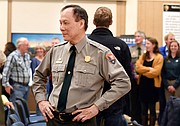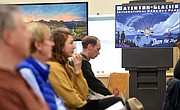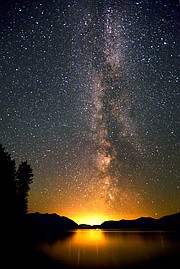Waterton-Glacier receives Dark Sky designation
One of the dwindling number of places left in the U.S. where nighttime visitors can gaze upward for a largely unabridged view of the Milky Way, Waterton-Glacier International Peace Park on Friday became the world’s first trans-boundary International Dark Sky Park.
Officials from Glacier and Waterton Lakes national parks, as well as representatives from the Blackfeet Tribe, Glacier National Park Conservancy and the International Dark Skies Organization, made the announcement at an event in West Glacier Friday afternoon. The designation is the culmination of a decade of work by the parks to reduce light pollution from developments inside their borders while using specialized instruments to measure the levels of darkness on clear, moonless nights.
Glacier Park Superintendent Jeff Mow told the crowd, gathered in the West Glacier Community Building, that the designation is “only the beginning of more to come,” as both parks will continue programs to replace older light fixtures with those meeting dark-sky-friendly requirements. And while the issue of light encroachment on the park’s celestial ceiling gets overshadowed by high-profile issues like climate change, invasive species and crowding pressures, he said it’s nonetheless important from both ecological and visitor-experience perspectives.
“In some respects, for us this is an emerging issue,” Mow said. “When people established Glacier Park, they weren’t necessarily thinking of dark skies as one of these primary resources,” Mow said.
Since electric lights began dotting the landscape, 80 percent of Americans have lost the ability to identify the foggy outlines of the Milky Way Galaxy’s Orion Arm stretching overhead, according to Dave Ingram, with the International Dark Sky Organization.
Mow was joined by the counterpart from Waterton Lakes National Park, which joins Glacier at the Canadian border.
“We understand the night sky as a universal resource for all humanity,” Waterton Superintendent Ifan Thomas told the crowd. “Darkness has inspired poets. It’s inspired authors, artists, explorers and storytellers for millenia.”
While the effort to secure the designation has been in the works since 2006, park intern Iree Wheeler was recognized for her work over the last two years to coordinate that effort. After graduating with an environmental science degree from the University of Washington, Wheeler was hired by the park in spring of 2015 to navigate the application process for the parks. Like Mow, she credited the organizations and volunteers that worked throughout the last few years to push the lengthy process over the finish line.
“There were all these people that were totally devoted to this, it was really impressive,” she said.
Wheeler said the historic structures peppered throughout the two parks presented some of the biggest challenges, with even the light fixtures subject to the terms of their historic-site designations. In some instances, those locations also offered opportunities to prioritize more remote places for reducing light pollution, such as the park’s presence in Polebridge.
“Those are areas where people can get the truest dark-sky experience,” Wheeler said.
Unlike Glacier, Waterton Lakes includes a large town site within its borders, which provided a substantial barrier to the park meeting the requirements of the designation, such as retrofitting at least two-thirds of the light fixtures within the transboundary peace park with dark-sky-friendly lighting.
Waterton visitor experience officer Christy Gustavison said the Canadian park was able to use funding for infrastructure upgrades to replace many of those older lightbulbs. While the parks have not collectively reached the two-thirds threshold — meaning the designation is technically in a “provisional status” for now — Glacier’s natural resources manager, Mark Biel, said they are on pace to meet that requirement within the next two years.
The dark-sky designation also requires a robust educational program to teach visitors about the cultural and environmental importance of reducing light pollution. To that extent, officials from the two parks said they’ve collectively reached more than 30,000 visitors per year, through nighttime sky-viewing events and interpretive outreach.
Gustavison noted that even within the town site of Waterton, the park was able to hold a “Great World-Wide Star Count” event, and Biel said the park’s summertime “star parties” on Logan Pass attracted about 700 people per event. He also credited local organizations like the Big Sky Astronomy Club for dedicating more than 1,000 hours of volunteer time in the last year alone.
With special equipment and substantial staff time dedicated to the effort, achieving the trans-boundary dark-sky status wasn’t cheap. Mow noted that with national park budgets stretched increasingly thin relative to their workload, the designation would have been unlikely without funding from the Glacier National Park Conservancy. The organization’s vice-chair, John Donovan, was one of the main financiers of the effort, along with his wife, Dana.
“It is an illustration of how, through private philanthropy, we can bring together funds that the park cannot raise on its own, that we can do great projects that the park really cares about and its visitors enjoy, and use private philanthropy in situations where the federal budget will never allow funding that,” Donovan said. “We’ve reached a great milestone, there’s a lot of work still to be done, but the conservancy is committed to continuing to work to fund this project through completion.”
Reporter Sam Wilson can be reached at 758-4407 or by email at swilson@dailyinterlake.com.










